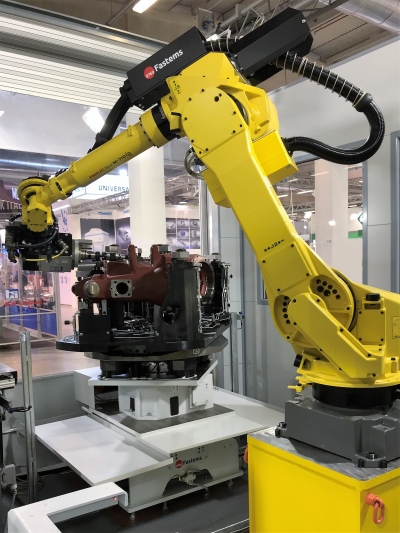
Fastems LLC offers a comprehensive range of automated robotic finishing solutions including grinding, polishing, deburring and brushing processes. Robotic finishing eliminates variations common in hand finishing operations and maximizes output of precisely finished parts. Fastems robotic systems provide speed and flexibility through a combination of control and software technology, spindle choices, and a variety of process tools and accessories.
Fastems is an independent integrator of robots and system solutions for all major robot brands, including FANUC, KUKA and others on customer request. In assembling robotic finishing systems, Fastems makes both pneumatic and electric spindles available, depending on which approach provides the best performance for certain applications. Pneumatic spindles have programmable compliance that enables tools to compensate for part feature variations such as those typical in castings. Pneumatic spindles are generally fitted with a single tool and are used in applications that do not require several different tools. Electric spindles, on the other hand, are suited to applications that require a large number of tools or where tool changes are frequent. Electric spindles provide ample power, feature programmable rotational speeds and permit accurate tracing of control variables.
A large selection of tooling for either type of spindle enables users to custom-tailor processes for specific applications. Process tools include burrs, brushes, grinding stones, abrasive and flap-style wheels, as well as specially engineered tools.
Fastems provides both on-line and off-line programming options. For product families with relatively limited variations, on-line programming at the finishing cell is a quick and time-efficient solution. For parts that change frequently and have complex geometries, programming off-line employs FASTSIMU, Fastems’ off-line programming software. FASTSIMU combines feature-based CAD models with CAM-path based toolpath programming, facilitating creation of complex robotic programs off-line while the finishing cell operations continue uninterrupted.
A selection of engineered accessories enables users to customize robotic finishing systems to fit their own part requirements and shop conditions. Options include spindle cooling systems, tool presence sensors, application-specific process control sensors and Renishaw touch probes. Spindle and tool cabinets are offered for use with electric spindles, and spindle racks for applications employing pneumatic spindles. Environmental and ergonomic accessories, such as sound-isolated or flushproof housings and dust and fume extraction systems, are also available.
“Fastems automated finishing systems enable users to save time, produce consistently precise parts, and relieve their employees of tedious and tiring hand finishing activities,” said David Suica, president of Fastems LLC.
Contact Details
Related Glossary Terms
- abrasive
abrasive
Substance used for grinding, honing, lapping, superfinishing and polishing. Examples include garnet, emery, corundum, silicon carbide, cubic boron nitride and diamond in various grit sizes.
- brushing
brushing
Generic term for a curve whose shape is controlled by a combination of its control points and knots (parameter values). The placement of the control points is controlled by an application-specific combination of order, tangency constraints and curvature requirements. See NURBS, nonuniform rational B-splines.
- computer-aided design ( CAD)
computer-aided design ( CAD)
Product-design functions performed with the help of computers and special software.
- grinding
grinding
Machining operation in which material is removed from the workpiece by a powered abrasive wheel, stone, belt, paste, sheet, compound, slurry, etc. Takes various forms: surface grinding (creates flat and/or squared surfaces); cylindrical grinding (for external cylindrical and tapered shapes, fillets, undercuts, etc.); centerless grinding; chamfering; thread and form grinding; tool and cutter grinding; offhand grinding; lapping and polishing (grinding with extremely fine grits to create ultrasmooth surfaces); honing; and disc grinding.
- polishing
polishing
Abrasive process that improves surface finish and blends contours. Abrasive particles attached to a flexible backing abrade the workpiece.
- process control
process control
Method of monitoring a process. Relates to electronic hardware and instrumentation used in automated process control. See in-process gaging, inspection; SPC, statistical process control.
- toolpath( cutter path)
toolpath( cutter path)
2-D or 3-D path generated by program code or a CAM system and followed by tool when machining a part.






